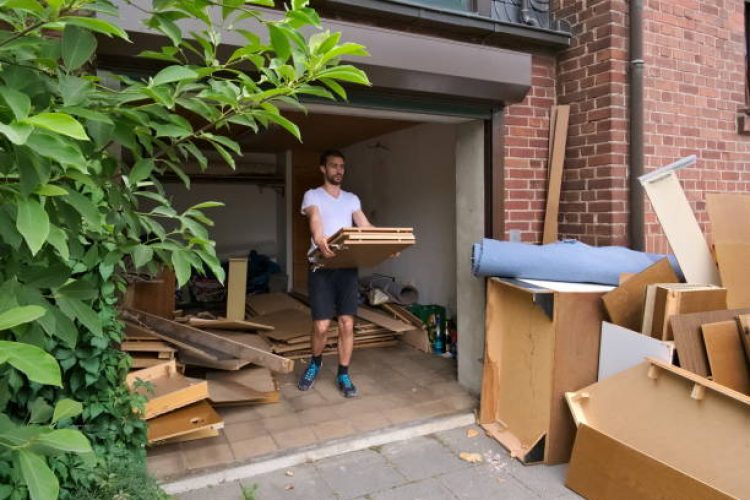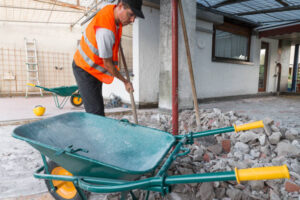Home remodeling projects can breathe new life into your space, but they come with an environmental cost. According to the U.S. EPA, home remodeling accounts for 22 percent of all construction and demolition waste generated nationally. Even more striking, EPA estimated that 600 million tons of C&D debris were generated in the United States in 2018. The good news? With a plan and a little extra time, much of that waste can be avoided or diverted for reuse or recycling.
Whether you’re planning a minor bathroom refresh or a major home overhaul, this guide will show you practical strategies to minimize waste, save money, and make your remodeling project more environmentally friendly.
Why Waste Reduction Matters in Home Remodeling
Any given remodeling job can potentially generate more waste than a household generates in a year, making it crucial to address construction and demolition (C&D) waste as part of your renovation planning. Beyond the environmental impact, waste reduction can lead to significant cost savings and create a more organized, efficient project timeline.
Plan Before You Demolish
Start with the Waste Hierarchy
First consider reduction, then reuse, and finally, recycling. This simple framework should guide every decision throughout your remodeling project.
Before starting your project:
- Spend some time thinking about what types of waste will be generated, then consider whether you can achieve the same desired outcomes without generating as much waste
- Create a detailed waste management plan that identifies materials you can salvage, donate, or recycle
- Consult with your contractor about their waste reduction strategies and commitment to sustainability
Design Smart to Reduce Waste
When planning a remodel, you can reduce waste by planning rooms, ceiling heights, or openings in two foot increments (to reduce odd-sized pieces). This approach minimizes material cuts and leftover scraps.
Consider these design strategies:
- Think smaller and better: Smaller homes generate less waste over a lifetime of use and maintenance. Spend more per square foot on higher-quality materials and finishes instead of maximizing the total square footage of your project
- Preserve existing elements: One of the most sustainable remodeling strategies is to make surgical rather than wholesale changes to your home, and retain existing elements. Original trim, hardwood flooring, and even old doors can often be repaired, refinished, or repurposed
- Design for longevity and adaptability so your renovated space can evolve with your changing needs
Reuse What You Already Have
Before you tear everything out, consider what can be saved and refreshed:
Refresh Rather Than Replace
Cabinets and vanities can take on a new life with a fresh coat of paint or stain and new hardware. Sinks and tubs can be refreshed by replacing the faucet rather than the entire sink. This approach not only reduces waste but also saves money and can preserve character in older homes.
Materials worth salvaging:
- Cabinets and built-ins
- Doors and windows
- Hardware and fixtures
- Flooring (if in good condition)
- Trim and molding
Donate Usable Materials
If you can’t reuse items yourself, consider donating them. Cabinets, flooring, sinks, light fixtures and much more can be found at used building material stores across the metro. Architectural Antiques, Bauer Brothers Salvage, Better Futures Minnesota, City Salvage, Guilded Salvage and Habitat for Humanity ReStore are all good options for used and period-specific building materials.
Choose Sustainable Materials
Buy Recycled and Reclaimed
When designing your project, close the waste loop by incorporating materials that contain recycled content. You can find many materials made with recycling content, including glass tile, carpet and latex paint.
Additionally, incorporating reclaimed wood, recycled glass, or cork flooring adds character and reduces waste.
Source from Salvage and Secondhand Markets
Craigslist, eBay and online garage sale groups are also good options for finding used or surplus building materials. Shopping secondhand for building materials offers unique finds while preventing perfectly good materials from ending up in landfills.
Implement Effective Waste Management
Set Up Proper Waste Sorting
Organize your job site with clearly labeled bins for:
- Recyclable metals (steel, copper, aluminum)
- Wood waste
- Drywall and plaster
- Cardboard and packaging
- General trash
Professional dumpster providers help ensure that recyclable and hazardous materials are properly separated and disposed of according to local regulations. This minimizes environmental impact and maintains compliance with community standards.
Choose the Right Dumpster Size
For minor upgrades—like bathroom remodels, flooring replacements, or attic cleanouts—a 10-yard dumpster is typically sufficient. Kitchen renovations or multi-room updates may require a 20-yard container. Choosing the appropriate size helps control costs and prevents overfilling.
Maximize Recycling Opportunities
The recycling potential for construction materials is impressive. In 2018, 76% of all C&D waste in the U.S. was recovered or recycled, demonstrating that with proper planning, most remodeling waste can be diverted from landfills.
Highly Recyclable Materials
Many materials from remodeling projects—such as metal, wood, and concrete—can be recycled instead of discarded. Here’s what you should prioritize:
Metal: 98% of steel in construction and demolition projects is recycled to new uses, making it one of the most valuable materials to separate and recycle.
Concrete and Asphalt: Over 95% of concrete and asphalt concrete waste, the largest contributors to total C&D waste, was recovered in 2018.
Wood: Can be recycled into mulch, compost, engineered wood products, or donated for reuse projects.
Partner with Recycling-Focused Services
Partnering with a company that values sustainability ensures these materials are sorted and processed appropriately. Renting a dumpster helps consolidate waste, making recycling and sorting more efficient. Instead of scattered piles of debris, all materials are collected systematically for transport to recycling or processing facilities.
Deconstruction vs. Demolition
Consider deconstruction—the careful dismantling of structures to salvage components—rather than traditional demolition. While it takes more time upfront, deconstruction maximizes material recovery and can even provide tax benefits when you donate salvaged materials.
Rather than discarding old materials, find creative ways to recycle and repurpose them during your remodel. Old wood, bricks, and other salvaged materials can find new life as one-of-a-kind furniture or décor. It’s a creative way to reduce waste, support your local community, and give your home a touch of personality.
Work with the Right Professionals
If you’re a homeowner, you can ask your contractor about their waste reduction strategies. And if you’re a contractor, you may find that a business can differentiate itself from the competition by minimizing construction waste.
Look for contractors who:
- Have established relationships with recycling facilities
- Include waste management plans in their bids
- Use precise measurements to minimize material waste
- Are experienced with deconstruction techniques
- Can provide references for sustainable projects
The Bottom Line
Minimizing waste during home remodeling isn’t just good for the environment—it’s a smart financial decision that can improve your project’s efficiency and timeline. By planning ahead, prioritizing reuse and recycling, choosing sustainable materials, and working with environmentally conscious professionals, you can significantly reduce the environmental impact of your renovation.
Remember, reducing waste takes extra effort. It may require some encouragement to make sure everyone (general contractor, subcontractors, and every worker) understands and follows the steps needed to reduce waste. However, the benefits—financial savings, environmental protection, and a more organized job site—make it well worth the investment.
Start your next remodeling project with sustainability in mind, and you’ll create not just a beautiful new space, but a greener future for everyone.
References
- Reducing Waste During Home Remodeling – Hennepin County
- Construction and Demolition Debris: Material-Specific Data – U.S. EPA
- 5 Ways to Reduce Remodeling Waste – Quality Edge
- 7 Sustainable Remodeling Tips for Your Next Home Project – Byggmeister
- How Dumpster Rental Simplifies Residential Remodeling Projects – North Penn Now












